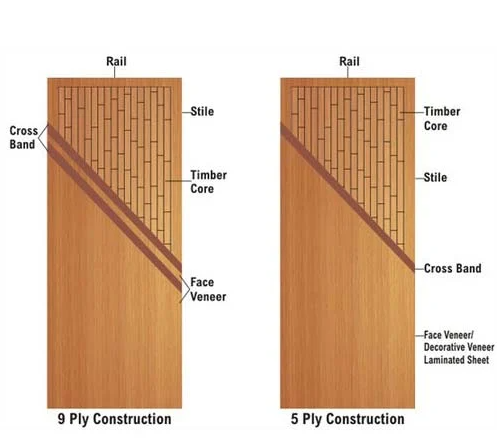
A flush door is a type of door that is characterized by its smooth and flat surface, without any raised or recessed panels. These doors are made by sandwiching a core material between two plywood or Medium Density Fiberboard (MDF) sheets. The core material can vary and may include materials like solid wood strips, particleboard, or hollow core construction.
Flush doors are popular for their simplicity, versatility, and modern appearance. They are commonly used in residential and commercial buildings and can be used for both interior and exterior applications.
There are different types of flush doors based on the materials used in their construction and the intended use. Here are some common types of flush doors:
- Solid Core Flush Door:
- These doors have a solid core made of materials like particleboard, MDF, or lumber pieces.
- Solid core flush doors provide better insulation and soundproofing compared to hollow core doors.

- Hollow Core Flush Door:
- These doors have a core that is hollow, typically constructed with a framework of timber or cardboard.
- Hollow core doors are lighter and more affordable than solid core doors but may not provide as much insulation or soundproofing.
- Laminated Flush Door:
- Laminated flush doors are covered with a layer of decorative laminate on the surface.
- This type of door is popular for its aesthetic appeal and is available in a variety of finishes and colors.
- Veneer Flush Door:
- Veneer flush doors have a thin layer of natural wood veneer applied to the surface.
- This type of door provides the look of real wood while being more affordable than solid wood doors.
- Aluminum Flush Door:
- Aluminum flush doors have an aluminum facing, making them suitable for exterior applications.
- They are durable, weather-resistant, and often used in commercial and industrial settings.
- Fire-Rated Flush Door:
- These doors are designed to withstand fire for a specified period, providing fire protection in buildings.
- Fire-rated flush doors are commonly used in areas where fire safety is a concern.

When choosing a flush door, it’s important to consider factors such as the door’s core material, intended use, and aesthetic preferences.
Advantages & Disadvantage of Flush Doors
| Advantages of Flush Doors | Disadvantages of Flush Doors |
|---|---|
| 1. Simplicity and Modern Appearance | 1. Limited Insulation (Hollow Core) |
| 2. Versatility | 2. Durability (Hollow Core) |
| 3. Cost-Effective | 3. Limited Design Options |
| 4. Smooth Surface | 4. Vulnerability to Water Damage |
| 5. Lightweight (Hollow Core) | 5. Weight (Solid Core) |
| 6. Easy Maintenance | 6. Limited Natural Wood Options |
| 7. Customization | 7. Fire Rating (Standard) |
Advantages of Flush Doors:
- Simplicity and Modern Appearance:
- Flush doors have a clean and modern look, making them suitable for contemporary interior designs.
- Versatility:
- They are versatile and can be used for both interior and exterior applications.
- Cost-Effective:
- Flush doors are often more affordable compared to other types of doors, especially solid wood doors.
- Smooth Surface:
- The smooth, flat surface of flush doors provides a blank canvas for various finishes, paints, and veneers.
- Lightweight (Hollow Core):
- Hollow core flush doors are lighter, making them easier to handle and install.
- Easy Maintenance:
- They are generally easy to clean and maintain, especially if they have a pre-finished surface.
- Customization:
- Flush doors are available in various materials, finishes, and designs, allowing for customization to suit different preferences.
- Sound Insulation (Solid Core):
- Solid core flush doors offer better sound insulation compared to hollow core doors.
Disadvantages of Flush Doors:
- Limited Insulation (Hollow Core):
- Hollow core flush doors may not provide as much insulation against sound or temperature as solid core doors.
- Durability (Hollow Core):
- Hollow core doors may be less durable than solid core doors and may be more prone to damage.
- Limited Design Options:
- While flush doors are available in various finishes, they may not offer the intricate designs and detailing found in some other door types.
- Vulnerability to Water Damage:
- If not properly sealed or protected, the core of flush doors, especially those with particleboard or similar materials, can be susceptible to water damage.
- Weight (Solid Core):
- Solid core flush doors are heavier, which can make them more challenging to handle during installation.
- Limited Natural Wood Options:
- While veneer flush doors provide the look of real wood, they may not have the same aesthetic appeal as solid wood doors with natural wood grain.
- Fire Rating (Standard):
- Standard flush doors may not have fire-resistant properties, so if fire resistance is a requirement, a fire-rated flush door may be necessary.
When choosing a flush door, it’s important to consider the specific requirements of the application, the desired aesthetics, and the budget constraints to determine whether the advantages outweigh the disadvantages for a particular use case.